- Home
- Nevil Shute
No Highway
No Highway Read online
FIRST VINTAGE INTERNATIONAL EDITION, OCTOBER 2010
Copyright © 1948 by William Morrow & Co. Inc.
All rights reserved. Published in the United States by Vintage Books, a division of Random House, Inc., New York. Originally published in book form in Great Britain by William Heinemann Ltd., London and in the United States by William Morrow & Co. Inc., New York, in 1948. This edition first published in Great Britain by Vintage Books, an imprint of The Random House Group Limited, London, in 2009. Copyright © The Trustees of the Estate of Nevil Shute Norway.
Vintage is a registered trademark and Vintage International and colophon are trademarks of Random House, Inc.
This is a work of fiction. Names, characters, places, and incidents either are the product of the author’s imagination or are used fictitiously. Any resemblance to actual persons, living or dead, events, or locales is entirely coincidental.
eISBN: 978-0-307-47412-4
www.vintagebooks.com
v3.1_r1
Contents
Cover
Title Page
Copyright
Chapter 1
Chapter 2
Chapter 3
Chapter 4
Chapter 5
Chapter 6
Chapter 7
Chapter 8
Chapter 9
Chapter 10
Chapter 11
Chapter 12
Author’s Note
1
WHEN I WAS put in charge of the Structural Department of the Royal Aircraft Establishment at Farnborough, I was thirty-four years old. That made a few small difficulties at first, because most of my research staff were a good deal older than I was, and most of them considered it a very odd appointment. Moreover, I wasn’t a Farnborough man; I started in a stress office in the aircraft industry and came to Farnborough from Boscombe Down, where I had been technical assistant to the Director of Experimental Flying for three years. I had often been to Farnborough, of course, and I knew some of the staff of my new department slightly; I had always regarded them as rather a queer lot. On closer acquaintance with them, I did not change my views.
In spite of my appointment from outside I found them quite co-operative, but they were all getting on in years and beginning to think more about their pensions than about promotion. When I got settled in I found that each of them had his own little niche and his own bit of research. Mr. Morrison, for example, was our expert on the three-dimensional concentrations of stress around riveted plate joints and he was toying with a fourth dimension, the effect of time. What he didn’t know about polarised light wasn’t worth knowing. He had been studying this subject for eight and a half years, and he had a whole room full of little plate and plastic models broken upon test. Every two years or so he produced a paper which was published as an R. and M., full of the most complicated mathematics proving to the aeroplane designer what he knew already from his own experience.
Mr. Fox-Marvin was another of them. I discovered to my amazement when I had been in the department for a week that Fox-Marvin had been working since 1935 on the torsional instability of struts, with Miss Bucklin aiding and abetting him for much of the time. They were no laggards at the paper work, for in that time they had produced typescript totalling well over a million words, if words are a correct measure of reading matter that was mostly mathematical. At the end of all those years they had got the unstabilised, eccentrically loaded strut of varying section just about buttoned up, regardless of the fact that unstabilised struts are very rare today in any aircraft structure.
I knew that I had been appointed from outside the Royal Aircraft Establishment as a new broom to clean up this department, and I had to do a bit of sweeping. I hope I did it with sympathy and understanding, because the problem of the ageing civil servant engaged in research is not an easy one. There comes a time when the research worker, disappointed in promotion and secure in his old age if he avoids blotting his copybook, becomes detached from all reality. He tends to lose interest in the practical application of his work to the design of aeroplanes and turns more and more to the ethereal realms of mathematical theory; as bodily weakness gradually puts an end to physical adventure, he turns readily to the adventure of the mind, to the purest realms of thought where in the nature of things no unpleasant consequences can follow if he makes a mistake.
It is easy to blackguard these ageing men and to deride their unproductive work, easy and unprofitable and unwise. Short-term ad hoc experiments to solve a particular problem in the design of aircraft were the main work of my department, but I was very well aware that basic research also has a place in such a set-up, the firm groundwork of pure knowledge upon which all useful short-term work must be erected. In the great mass of typescript chaff turned out by the Fox-Marvins and the Morrisons within the R.A.E. were hidden grains of truth. Callow young men entering the Establishment from the universities, avid for knowledge and enthusiastic in their early years, would read through all this guff and take it very seriously, and find and recognise the little grains of truth, and take them into their experience and use them as their tools for short-term work.
I had to steer a middle course, therefore, as every sensible new broom must do. Within the first year I had transferred two of the oldest of my scientific officers, and I had changed the line of three others. It was a busy year, because I got married soon after I went to Farnborough. Shirley was a local girl who had taught drawing and music in a little school in Farnham before the war; when the school evacuated she had become a tracer at the R.A.E. In the fourth year of the war she was sent to Boscombe Down to work in the drawing office; she had her desk and drawing board just outside my little glass cubicle, so that every time I looked up from my calculations I saw her auburn head bent over her tracing, which didn’t help the calculations. I stood it for a year, high-minded, thinking that one shouldn’t make passes at the girls in the office. Then we started to behave very badly, and got engaged.
We got a flat in Farnham with some difficulty and got married into it soon after I took up my new job. It was a very small flat, with just one bedroom and a sitting-room and a bathroom, and a kitchen that we had our meals in. It was big enough for all we wanted, and we were very happy. There wasn’t much for Shirley to do, since I was away all day, and we didn’t plan to start a family for a year or so. So she went back to teaching music and drawing in the school that she had taught in before, and one of the girls she taught was Elspeth Honey.
She told me about Elspeth one evening when we were siting after the nine-o’clock news. Shirley was sewing a slip or something, and I was working at the first paper that I had been asked to read before the Royal Aeronautical Society, which I called “Performance Analysis of Aircraft Flying at High Mach Numbers.” It was something of a distinction that I had been asked to read this thing, and I was very busy working on it in the evenings.
Shirley told me about Elspeth as we sat there; she was teaching her to play the piano at that time. “She’s such a funny little thing,” she said thoughtfully. “I can’t make out if she’s immensely clever or just plain bats.”
I looked up, laughing. “I’ve been wondering that about her father ever since I took over the department.” Because Mr. Theodore Honey was another one of the old gang of budding Einsteins that I had inherited. So far I had left him alone, feeling that the work that he was doing on fatigue in light alloy structures was probably useful. But I must admit that there were moments when I had my doubts, when I wondered if Mr. Honey was not sliding quietly into an inoffensive form of technical mania.
Shirley bent over her sewing. “She looks so odd,” she said presently, “with her straight black hair and her white little face, and those ugly frocks she wears. She never seems to play with the other children. And she
does say the queerest things sometimes.”
“What sort of things?” I asked. I was not quite happy in my mind about her father; subconsciously I was interested in anything to do with the Honey family.
Shirley looked up from her sewing, smiling. “Pyramidology,” she said.
I stared at her. “What’s that?”
She mocked me. “Call yourself a scientist, and you don’t know pyramidology! Even Elspeth knows that.”
“Well, I don’t. What is it?”
“It’s all about the Great Pyramid, in Egypt. Prophecies and all that sort of thing.”
I grinned. “That’s not the sort of science that I learned at college. Is that what they teach at your school?”
She bent to her work again, and said quietly, “No, it’s just Elspeth. She came and asked me if she could do her practising in break on the school piano, and I asked her why she couldn’t do it at home. She said there wasn’t time now, because she was helping her Daddy with his pyramidology. I asked her what that was, and she told me all about it. It seems that there’s a sort of directional bearing from two points in the Great Pyramid which is lined up on Iceland, just like a radar beam, and that’s where Our Lord will come down to earth at the end of the world, and that’s going to be quite soon. But Elspeth says her Daddy found a mistake in the calculations and he’s working it all out again, and she’s been helping him with the sums. She says it’s all terribly exciting because her Daddy thinks it will turn out that the ray goes through Glastonbury, because Jesus Christ came to live in Glastonbury when he was a young man and so He’ll probably want to go back there when He comes again. But Elspeth hopes that the ray will go through Farnborough because that’s the most important place in the world and, besides, it’s where her Daddy works.”
Shirley said all this without a smile, concentrated on her sewing. I stared at her incredulously. “Does Mr. Honey believe all this?”
She looked up at me. “He must do, mustn’t he. Or he wouldn’t have told Elspeth. It’s such a pity that she hasn’t got a mother. It’s rather unnatural for a kid of twelve to go on like that, don’t you think?”
“What happened to her mother?” Anything about Honey was of interest to me now.
“I think she died during the war. Elspeth and her father live in one of those little houses in Copse Road.”
I nodded, visualising the small villas. “Who looks after them?”
“I don’t think anybody does. I believe they’ve got a charwoman who comes in now and then. But Mr. Honey does the cooking for them both. I know that, because Elspeth told me that she cooks the breakfast on Sundays, but next year she’s going to be allowed to do it every day.”
“She’s twelve, is she.”
“Just twelve—her birthday was last month. But she’s small for her age. You wouldn’t think to look at her that she was more than ten.”
I sat deep in thought. I was visualising my Mr. Honey going home each evening to his little house to cook a high tea for his little girl, and then to spend an hour telling her about the tangled prophecies connected with the Great Pyramid, and then putting her to bed. Did he hear her say her prayers, and if so, were they all about the Pyramid? And after that, alone in his small villa, what did he do? Did he go out to the cinema? I did not think that he was one to spend the evening in a pub—or was he. Did he spend the evenings pondering the energy absorption factor of light alloy structures, or checking the position of the stars in the year 2141 B.C., the datum year of the Great Pyramid. I wanted to know all I could about his background, because I had not then made up my mind if he was a useful research scientist or not. What Shirley had told me was not very reassuring.
“I was talking to Sykie about Elspeth,” she said quietly. “Of course, Sykie doesn’t really know much botany, only just enough to teach the children something elementary. Elspeth got her floored in class the other day by saying that a buttercup was pentamerous, and Sykie didn’t know if that was something rude or not. And so she made Elspeth tell them what she meant, and what she meant was that the buttercup has five of everything—five sepals in the calyx, five petals in the corolla, five carpels in the pistil, and so on. Sykie looked it up in the book afterwards, and she was quite right. But then she went on to say that the Bible was septamerous because it had seven of everything, and that’s why seven was a holy number. Sykie got out of that one by saying that it wasn’t botany.”
“Did Mr. Honey tell her that—about the Bible.”
“I suppose he must have done. She didn’t learn it at the school.”
I went to the department next day resolved to give a good part of my time to checking up on Mr. Honey and the progress of his research. I had not bothered him a great deal up till then, because it seemed to me that the work he was engaged on was of real importance to the modern aircraft, which was more than could be said for some of the other stuff that I had found going on in the place. Because the work was of importance to the aviation world it was imperative that it should be properly conducted, and although Mr. Honey’s religious beliefs were no concern of mine a man who is eccentric in one sphere of his interests may well be eccentric in another.
As I have said, Mr. Honey was working on fatigue in aircraft structures. Fatigue may be described as a disease of metal. When metals are subjected to an alternating load, after a great many reversals the whole character of the metal may alter, and this change can happen very suddenly. An aluminium alloy which has stood up quite well to many thousands of hours in flight may suddenly become crystalline and break under quite small forces, with most unpleasant consequences to the aeroplane. That is the general story of the effect that we call fatigue in aircraft structures, and we don’t know a great deal about it. Mr. Honey’s duty was to try and find out more.
I went down to his stamping ground to see what he was doing. The Farnborough buildings at that time were a mixture of the old and the new, and Mr. Honey occupied a shabby little room of glass and beaverboard in the annexe to the old balloon shed. Here he sat all day and covered sheet after sheet of foolscap paper with the records of his research, or pored over the work of scientists in many languages; he could read both French and German fluently. Outside his office an area of the ground floor of the balloon shed had been allocated to his work, and here he had quite a major experiment in progress.
The Rutland Reindeer was the current Transatlantic airliner at that time, and still is, of course; the Mark I model, which went into production first, had radial engines, though now they all have jets. Two years before I came upon the scene the strength tests of the tailplane had been carried out in my department, and for this two tailplanes had been provided by the Company for test to destruction. They were quite big units, fifty-five feet in span, as big as a twin-engined bomber’s wing. It had only been necessary to break one of these expensive tailplanes for the strength tests for the airworthiness of the machine, and the other one remained upon our hands until eighteen months later Mr. Honey put in a plea for it, and got it.
He had set it up in the balloon shed, horizontally as it would be in flight. He had designed a considerable structure of steel girders to support it at the centre section as it would be held in the aircraft, and this structure was pivoted in such a way that it could be vibrated, or jiggeted, by a whacking great electric motor driving a whole battery of cams to simulate the various harmonics that occur in flight. He had chosen a loading for the tailplane that would reproduce the normal cruising flight conditions, and he had started up the motor a couple of months before and sat back to wait for something to happen.
All that was going on as I was settling in to my new job and as my predecessor had authorised it I had to let it take its course, though I was not too happy about it. I had a feeling that a competent researcher could have got his data from a less expensive test, and apart from that the thing was a considerable nuisance for the noise it made. It may be possible to make mechanical vibrations without making noise, but it’s not often done, and this thing could be h
eard all over the Establishment. And apparently it was going to go on for ever, because nobody but Mr. Honey thought that tail would ever break by reason of what he was doing to it. It looked much too strong.
Honey got up as I went into his office. He was a smaller man than I am, with black hair turning grey; he was dressed in a very shabby suit that had been cheap to start with. He always looked a bit dirty and down at heels, and his appearance did not help him, because he was one of the ugliest men I have ever met. He had a sallow face with the features of a frog, and rather a tired and discontented frog at that. He wore steel-rimmed spectacles with very thick glasses, and he was as blind as a bat without them. Looking at him, my wife’s description of his daughter came into my mind, the dark-haired, white-faced, ugly little girl. Of course, she would be like that.
I said, “Morning, Mr. Honey. I’ve just come down to have a look at your tailplane. Anything happening to it yet?”
He said, “Oh no—everything is going on quite normally, so far. We can’t expect much yet, you know.” He had a few strain gauges mounted on various parts of the structure and he was reading them every three hours and graphing the readings. He showed me the curves illustrating the daily deformations of the structure as the test went on; after a few initial disturbances, due to the rivets bedding down, the carves flattened out and went along as a straight line. It was behaving just exactly as one would expect a safe structure to behave.
We stood and looked at it, and walked around it in the noise. Then we went back into his office, where the noise level was lower, and talked about it for a bit. I cannot say I was impressed with what I saw and heard. But for the expense of the set-up, I should have been very much tempted to call off the entire experiment.
“What’s your prognostication, Mr. Honey?” I asked presently. “How long do you think it will go on for?”
He smiled nervously, as the pure researchers always do when you try to pin them down to something definite. “One has to make so many assumptions,” he said. “The mass energy absorption factor, the factor that I call Um in my papers—that varies somewhat with each type of structure, and one really has to do a preliminary experiment to establish that.”

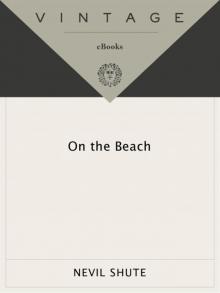 On the Beach
On the Beach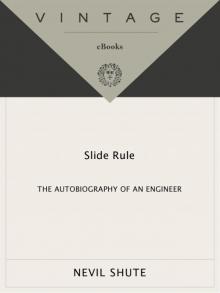 Slide Rule
Slide Rule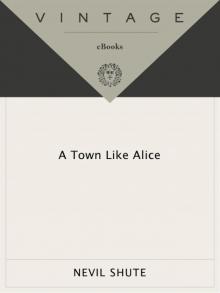 A Town Like Alice
A Town Like Alice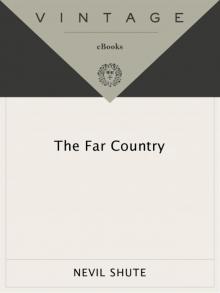 The Far Country
The Far Country Pied Piper
Pied Piper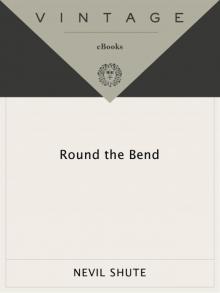 Round the Bend
Round the Bend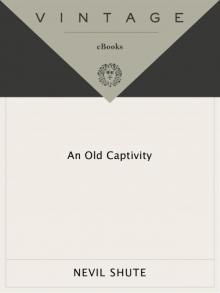 An Old Captivity
An Old Captivity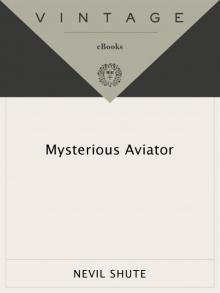 Mysterious Aviator
Mysterious Aviator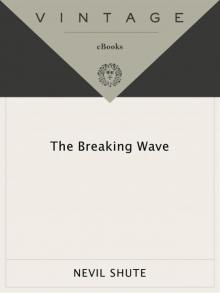 The Breaking Wave
The Breaking Wave Marazan
Marazan Lonely Road
Lonely Road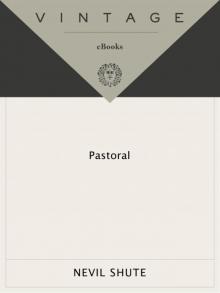 Pastoral
Pastoral No Highway
No Highway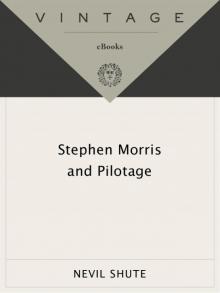 Stephen Morris and Pilotage
Stephen Morris and Pilotage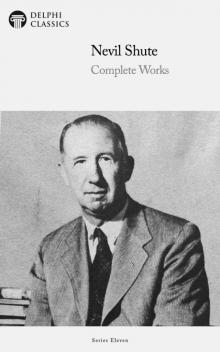 Complete Works of Nevil Shute
Complete Works of Nevil Shute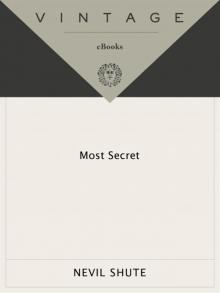 Most Secret
Most Secret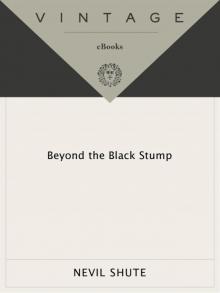 Beyond the Black Stump
Beyond the Black Stump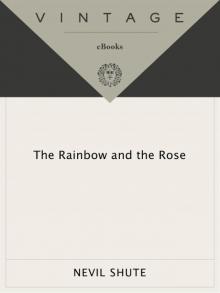 The Rainbow and the Rose
The Rainbow and the Rose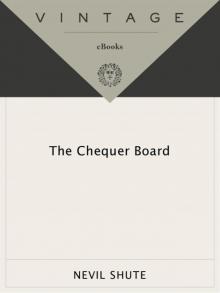 The Chequer Board
The Chequer Board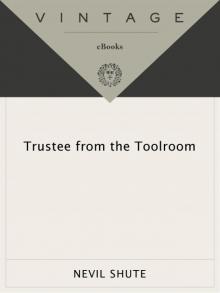 Trustee From the Toolroom
Trustee From the Toolroom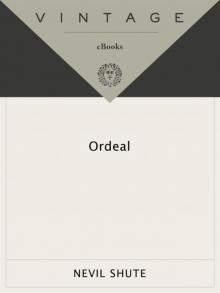 Ordeal
Ordeal Stephen Morris
Stephen Morris